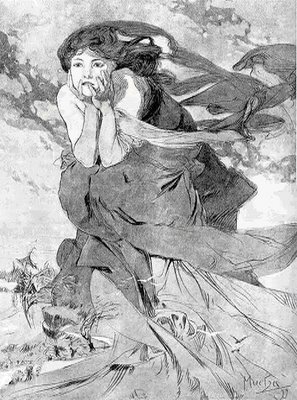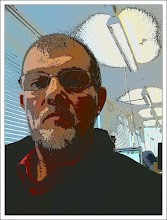 Alfons Maria Mucha was born in the town of Ivančice, Moravia. His singing abilities allowed him to continue his education through high school in the Moravian capital of Brno, although drawing had been his first love since childhood. He worked at decorative painting jobs in Moravia, mostly painting theatrical scenery, then in 1879 moved to Vienna to work for a leading Viennese theatrical design company, while informally furthering his artistic education. When a fire destroyed his employer's business in 1881 he returned to Moravia, doing freelance decorative and portrait painting. Count Karl Khuen of Mikulov hired Mucha to decorate Hrušovany Emmahof Castle with murals, and was impressed enough that he agreed to sponsor Mucha's formal training at the Munich Academy of Fine Arts.
Alfons Maria Mucha was born in the town of Ivančice, Moravia. His singing abilities allowed him to continue his education through high school in the Moravian capital of Brno, although drawing had been his first love since childhood. He worked at decorative painting jobs in Moravia, mostly painting theatrical scenery, then in 1879 moved to Vienna to work for a leading Viennese theatrical design company, while informally furthering his artistic education. When a fire destroyed his employer's business in 1881 he returned to Moravia, doing freelance decorative and portrait painting. Count Karl Khuen of Mikulov hired Mucha to decorate Hrušovany Emmahof Castle with murals, and was impressed enough that he agreed to sponsor Mucha's formal training at the Munich Academy of Fine Arts.
Mucha moved to Paris in 1887, and continued his studies at Académie Julian and Academie Colarossi while also producing magazine and advertising illustrations. In 1894, he produced the artwork for a lithographed poster advertising Sarah Bernhardt at the Theatre de la Renaissance. Mucha's lush stylized poster art won him fame and numerous commissions.
Mucha produced a flurry of paintings, posters, advertisements, and book illustrations, as well as designs for jewellery, carpets, wallpaper, and theatre sets in what came to be known as the Art Nouveau style. Mucha's works frequently featured beautiful healthy young women in flowing vaguely Neoclassical looking robes, often surrounded by lush flowers which sometimes formed haloes behind the women's heads. His art nouveau style was often imitated. However, this was a style that Mucha attempted to distance himself from throughout his life; he insisted always that, rather than adhering to any fashionable stylistic form, his paintings came purely from within. He declared that art existed only to communicate a spiritual message, and nothing more; hence his frustration at the fame he gained through commercial art, when he wanted always to concentrate on more lofty projects that would ennoble art and his birthplace.
Mucha visited the USA from 1906 to 1910, then returned to the Czech lands and settled in Prague, where he decorated the Theater of Fine Arts and other landmarks of the city.
When Czechoslovakia won its independence after World War I, Mucha designed the new postage stamps, banknotes, and other government documents for the new nation.
He spent many years working on what he considered his masterpiece, The Slav Epic (Slovanská epopej), a series of huge paintings depicting the history of the Slavic peoples, gifted to the city of Prague in 1928. He had dreamt of completing a series such as this, a celebration of Slavic history, since he was young. At the outbreak of the Second World War he was arrested and questioned by German occupiers. He never recovered from the strain of this event, or seeing his home invaded and overcome. He died in Prague on July 14, 1939 and was interred there in the Vyšehrad cemetery.
Link:
